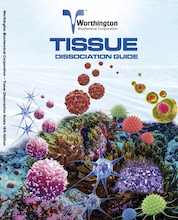For our international customers, please be advised that orders cannot be placed through our website by customers in countries with International Distributor representation.
Worthington Tissue Dissociation Guide
Methods and Materials: Trypsin for Cell Harvesting
In 1916, Rous and Jones used "the trypsin powders of Merck, Brubler and Kahlbaum" to digest the plasma clots in which living cells were growing in order to obtain a cell suspension for subculturing. Vogelaar and Erlichman in 1934 were the next researchers to utilize the digestive enzymes in a crude trypsin preparation to liquify the coagulated plasma in which human fibroblasts were growing prior to subculturing. Techniques using trypsin similar to those used today were introduced by Scherer, Syverton and Gey in 1953 to harvest the then newly cultivated HeLa cell strain for subculturing and biochemical analysis. These workers tested both recrystallized trypsin and NF 1:250 trypsin for cell harvesting and found that the purified trypsin was more potent and less toxic to cells. Nevertheless the NF 1:250 preparation was employed for routine harvesting simply because it was less expensive.
Relatively crude pancreatic preparations like NF 1:250 trypsin are still used today for cell harvesting in spite of the fact that they exhibit considerable lot-to-lot variability and contain extraneous substances and other enzymatic activities. Impurities in crude trypsin can cause unnecessary damage to cells and a reduction of cloning efficiency. Use of higher purity crystalline trypsin can eliminate many of these difficulties.
None of the contaminants present in the NF 1:250 materials appears to be essential for cell harvesting activity since purified trypsin is very effective for monolayer dissociation, and since crude NF 1:250 trypsin plus soybean trypsin inhibitor is ineffective.
McKeehan and Ham report markedly improved viability and multiplication potential to single cells in low serum medium when harvesting with crystalline trypsin at reduced temperatures, i.e., at 4°C.
Tissue Tables
The Worthington Tissue Tables provide references useful to researchers interested in tissue dissociation and cell harvesting procedures. The references are organized by Tissue and Species type and linked to PubMed citations. The Cell type, Enzymes, and Medium for each reference is provided.
To search by specific criteria, use the Tissue References Search Tool.
